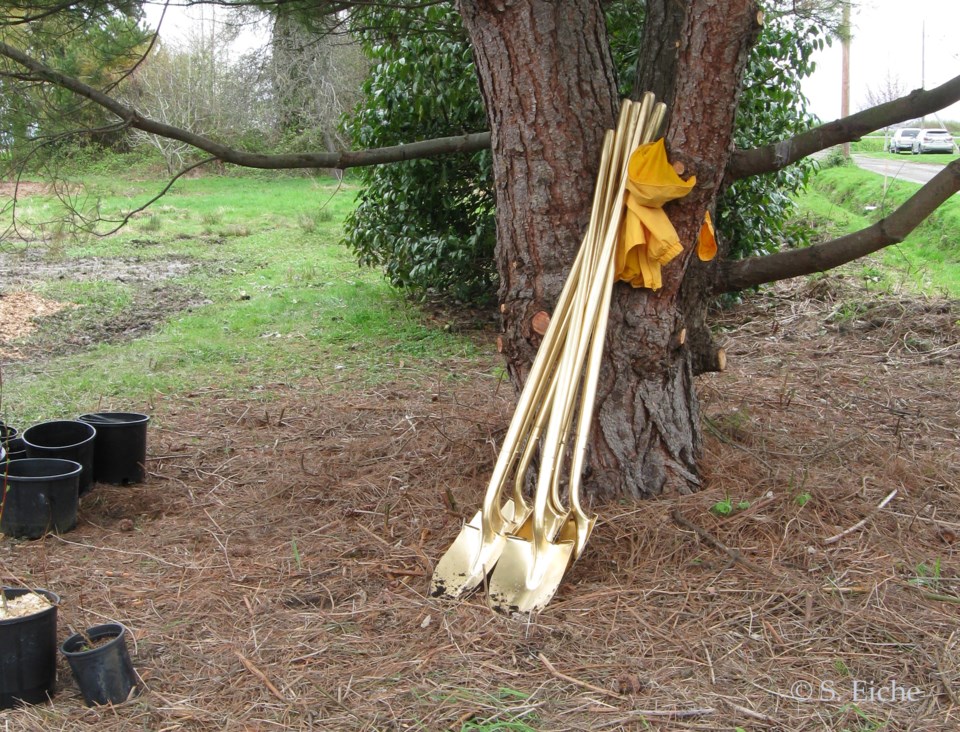I find it reassuring that traditions have so far managed to resist being taken over by the latest technology. Whether it’s a coronation, a ceremonial planting, or just a birthday, occasions such as these are still following scripts they’ve followed (mutatis mutandis) for a very long time.
Today, May 6, 2023, is the coronation of King Charles III. Two weeks ago, on April 22, the City of Richmond celebrated Earth Day by launching its first Mini Forest at Terra Nova Rural Park. Symbols of ceremony, rooted in the past, are important at such events, even if there’s naturally a substantial difference between the symbols of a coronation, ceremonial planting or birthday.
Symbol, which entered English in the early 15th century, comes from late Latin via the Greek symbolon, meaning a token, watchword, that which is thrown or cast together. Ceremony, written cerymonye in late 14th-century English, derives from the Latin caerimonia, sacred ceremony, a word sometimes linked to Caere, now known as Cerveteri, a town northwest of Rome, where the Etruscans performed ancient rites. The Latin celebratus, describing something numerously attended or much frequented, is the source of the word celebrate.
The symbol of the coronation that has given its name to the event is, of course, the crown. The word comes ultimately from the Latin corona, which originally referred to a wreath or garland. It’s related to the Greek korone, meaning a curved shape. Since the head has a curved shape, it’s easy to see how a headdress came to be called a crown. And if a person is to receive a mark of distinction — for bravery, honour, power, etcetera — it makes sense to place it on their head, high up where it’s most visible, at an event that is “numerously attended.”
When crowns were imprinted on coins, also the monetary unit was referred to as a crown. Iceland (Króna), Sweden (Krona), Norway (Krone) and Denmark (Krone) still have this type of currency. The British crown (equal to 5 shillings, or 60 pence) that many of us might once have had in our change purses was minted from 1707 to 1981, but the very first crown coin in Britain was gold, struck in 1526 by King Henry VIII (gold crowns were minted until 1662).
The St. Edward’s Crown (made 1661) that is placed on the head of King Charles III at the coronation weighs almost five lbs (I put a five lb bag of potatoes on my head — it was uncomfortably heavy). It’s made of solid gold, studded with hundreds of semi-precious stones. Gold is the metal chosen for the crown not just because it’s beautiful but above all because it’s rare. Gold is believed to have been produced in supernova nucleosynthesis and, recent research suggests, from the collision of the ultra-dense cores of dead stars (neutron stars).
Gold is also lavishly used in the two coaches carrying King Charles and Queen Camilla — the Diamond Jubilee State Coach (created 2012) for the ride from Buckingham Palace to Westminster Abbey, and the Gold State Coach (18th century) for the return to Buckingham Palace, with King Charles wearing the lighter (about two lbs) Imperial State Crown (made 1937, of gold, platinum, silver, diamonds, rubies, emeralds, sapphires, spinel, pearls, velvet, ermine).
Two weeks earlier, on April 22, councillors Andy Hobbs, Bill McNulty, Alexa Loo, Chak Au, together with Wilson Miao, MP of Richmond Centre, Emily Amon of Green Communities Canada, and Sharon MacGougan, President of the Garden City Conservation Society planted the first trees of the Mini Forest at Terra Nova Rural Park. They used appropriate symbols to celebrate the ceremonial significance of the act — golden shovels.
Symbols are important. They mark a special moment. And they need to be eye-catching. After all, how ceremonial would the coronation have been if King Charles had received a plastic crown? How ceremonial would Richmond’s tree planting have been if the seven “dignitaries” had been handed ordinary garden-shed shovels? And how ceremonial would a birthday be if instead of a cake with candles, there were to be a doughnut or a cookie?
Symbols, ceremonies and celebrations have the power to connect us — which in this day and age of rising loneliness is not a bad thing.
Sabine Eiche is a local writer and art historian with a PhD from Princeton University. She is passionately involved in preserving the environment and protecting nature. Her columns deal with a broad range of topics and often include the history (etymology) of words in order to shed extra light on the subject



